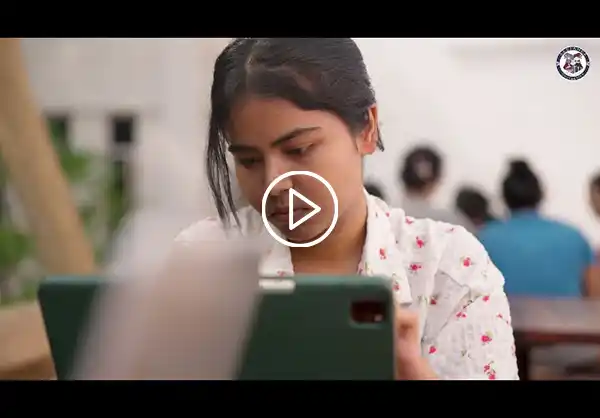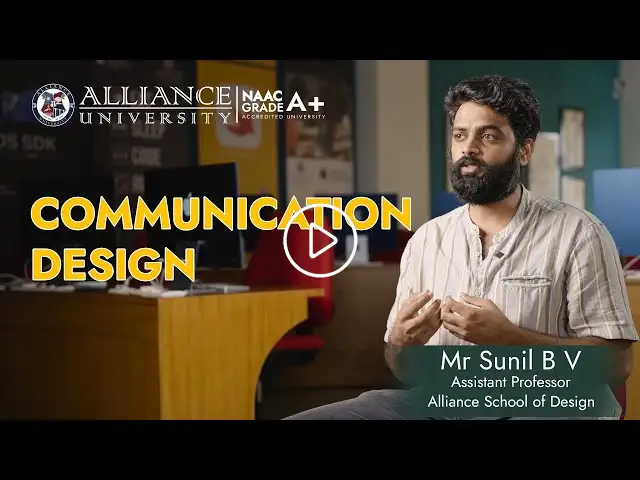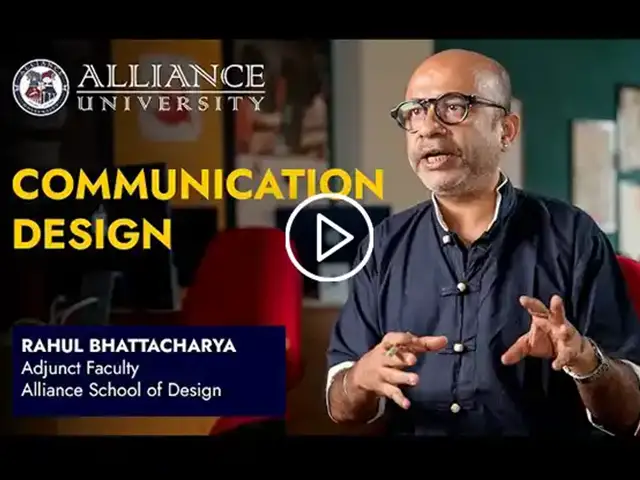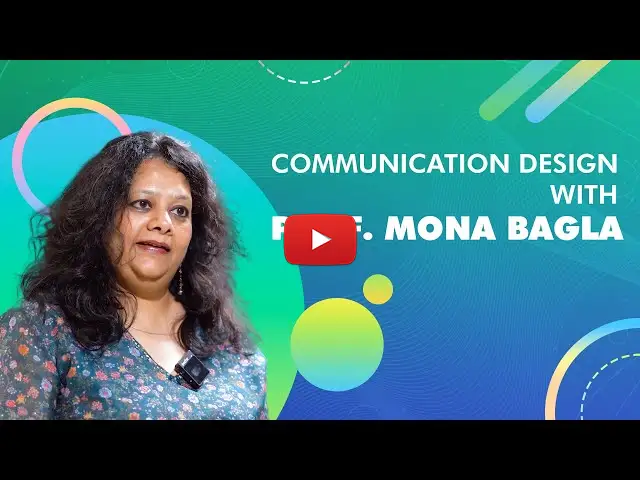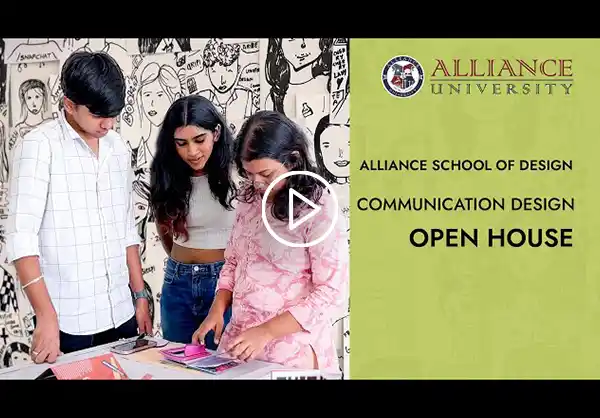Admission Enquiry
HELPLINE:
+9198860 02500 / +9196200 09825
Programmes
Bachelor of Design (B. Des.) - Visual Communication Design
Overview
Visual Communication Design is a diverse discipline, that is primarily focussed on meaning-making though visuals, both static and dynamic in the context of a brand, a story or a product and its audiences. The programme is practice-led and process-driven, while also grounding students in design theory relevant to both educational and commercial contexts. Its wide ambit covers fields such as research, print media, photography, video production, game design, digital design, new media, exhibition, and experience design.
It aims to prepare students in an experiential learning environment, fostering cultural awareness, critical thinking, experimentation, and the ability to think differently. Students engage with design courses like visual ethnography, brand understanding, typography, and social communication. The programme offers rigorous methods for integrating visual and textual research, exploring the designer’s role in society and questions of personal and social responsibility.
Duration
Four Years / Eight Semesters
Commence of the course
Course Duration
Mode of Study
Eligibility
10+2 from recognized Board / Council with minimum 50% marks.
A relaxation of 5% marks or its equivalent grade may be allowed for those belonging to SC / ST.
Key Features
Cultivate a deep understanding of visual narratives, content creation and digital processes.
Foster critical thinking, problem-solving, and analytical skills to tackle complex design challenges.
Gain a high degree of proficiency in visual design principles to create visually appealing and effective communication materials.
Train students to consider accessibility, inclusivity, and ethical design principles in their design process and solutions.
Encourage exploration of emerging technologies and media to develop innovative and future forward solutions.
Develop an understanding of the business and professional aspects of communication design.
FAQ's
Applicants must have successfully completed 10+2 (Class XII) or an equivalent examination from a recognised Board or Council with a minimum aggregate of 50% marks (45% for SC/ST candidates). The application process involves registering on the University’s admission portal, completing the online form, and submitting the required documents, including mark sheets, a creative portfolio, and a passport-sized photograph. Following payment of the application fee, candidates are assessed through the Alliance Design Aptitude Test (ADAT), a portfolio review, and a personal interview. Together, these assessments evaluate a candidate’s design aptitude, creativity, and potential.
Yes. Students receive hands-on training in industry-standard design software such as the Adobe Creative Suite, including Photoshop, Illustrator, InDesign, After Effects, and Premiere Pro, along with other contemporary design tools, as part of their academic and studio practice.
Yes. Alliance University places strong emphasis on experiential learning. Students have opportunities to work on internships with leading organisations, participate in real-time projects, and engage with live campaigns and client briefs. These experiences are carefully integrated into the curriculum, ensuring that classroom learning is translated into professional application. Through industry collaborations, the Centre for Industry Interaction, and faculty-led initiatives, students consistently gain exposure to the dynamic challenges of the creative sector.
Yes. Students at Alliance University are encouraged to present their work through exhibitions, portfolio reviews, and participation in design festivals, providing them with valuable exposure to professional critique and industry recognition. Alliance University annually hosts a Design Jury where design students showcase their work to industry leaders and experienced faculty members, providing them with valuable feedback and exposure to real-world perspectives.
Yes. The B. Des. programme is structured to provide significant exposure to interdisciplinary collaboration, enabling students to work at the intersection of business, media, and technology. This prepares them for the increasingly convergent nature of creative industries.
Alliance University offers comprehensive career support and placement services through its Career Advancement and Networking (CAN) office and the Centre for Industry Interaction (CII). These units facilitate internships, industry projects, and placement opportunities with reputed organisations, while also providing mentorship and career counselling to help students navigate the creative job market.
Graduates can pursue a wide range of creative career paths across design, media, advertising, branding, technology, and entertainment. Opportunities include roles such as graphic designer, brand strategist, UI/UX designer, digital illustrator, motion graphics artist, advertising and campaign designer, art director, and visual storyteller. With the programme’s emphasis on research-driven practice and industry exposure, graduates are also equipped for careers in emerging domains such as digital product design, interactive media, and creative entrepreneurship.
The programme equips students with both creative and industry-relevant skills. Alongside mastering design thinking, storytelling, and visual strategy, students gain proficiency in Adobe Creative Suite (Photoshop, Illustrator, InDesign, After Effects) and collaborative design platforms like Figma. They also engage with motion graphics, UI/UX fundamentals, digital illustration, and branding, ensuring they graduate with a skill set aligned with the demands of contemporary creative industries.
Yes. Alliance University provides a wide range of scholarships and financial aid opportunities for deserving and meritorious students. These are awarded on the basis of academic performance, national entrance exam scores, and other achievements such as excellence in sports or cultural activities, as well as on need-based considerations.
AUSAT: Students scoring 75% or above in Class 10 and 12 may receive 25%, 35%, or 50% tuition fee waivers.
UCEED: Scores ≥ 200 qualify for a 35% waiver; scores ≥ 150 qualify for 25%.
NID DAT: Percentiles ≥ 90 receive 50%; 85–89.99 receive 35%; 80–84.99 receive 25%
Students benefit from state-of-the-art facilities, including advanced digital design labs, industry-standard software, and professional tools for graphic design, animation, and UI/UX development. In addition, they have access to photography and video production studios, digital imaging labs, printmaking workshops, and collaborative makerspaces. These facilities replicate professional environments, ensuring students develop both creative vision and technical expertise.
Yes. Students are encouraged to explore freelance opportunities and independent projects alongside their academic studies. With the guidance of faculty mentors and the support of the Career Advancement & Networking (CAN) office, students can manage freelance work professionally and ethically. This enables them to build industry experience, expand their portfolios, and apply classroom learning to real-world briefs.
The B. Des. in Visual Communication Design follows a comprehensive curriculum that balances conceptual exploration with technical proficiency. Beginning with core courses in design principles, visual culture, and communication theory, the programme advances into typography, illustration, photography, branding, digital media, animation, motion graphics, UI/UX, and interactive design. Students also engage in design research, creative strategy, storytelling, and portfolio development. The curriculum is enriched with workshops, internships, and live projects, preparing graduates to thrive in the evolving landscape of visual communication.
Alliance University provides a learning environment that blends creativity, innovation, and professional relevance. The programme nurtures conceptual thinking, research-driven design practice, and technical mastery, while giving students access to cutting-edge facilities such as digital labs and media studios. With opportunities for internships, live projects, and client briefs, the curriculum ensures that students graduate with practical exposure and strong portfolios. A culture of mentorship, scholarships, and global networking further strengthens the student experience, making Alliance University an ideal choice for aspiring designers.
Graduates of the programme can enter diverse fields such as graphic design, advertising, branding, digital media, UI/UX, motion graphics, and visual storytelling. They are prepared for positions like art director, brand strategist, digital illustrator, campaign designer, or can establish themselves as freelance designers and entrepreneurs. The University’s industry networks and portfolio-driven training ensure that graduates are both employment-ready and equipped to shape their own creative journeys.
Visual Communication refers to the practice of conveying messages, narratives, and ideas through visual media. At Alliance University, this is taught as a blend of design principles, aesthetics, and technology applied across print, digital, and interactive platforms. Students engage with typography, photography, branding, motion graphics, UI/UX, and design research, while also studying communication theory and cultural contexts. By integrating creativity with critical inquiry, the programme prepares students to craft meaningful visual experiences and contribute to shaping culture and society through design.
Contact for Admissions
-
 Call Us
Call Us+91 63649 28122, 080 4619 9069
-
 Email Us
Email Usdesign@alliance.edu.in
